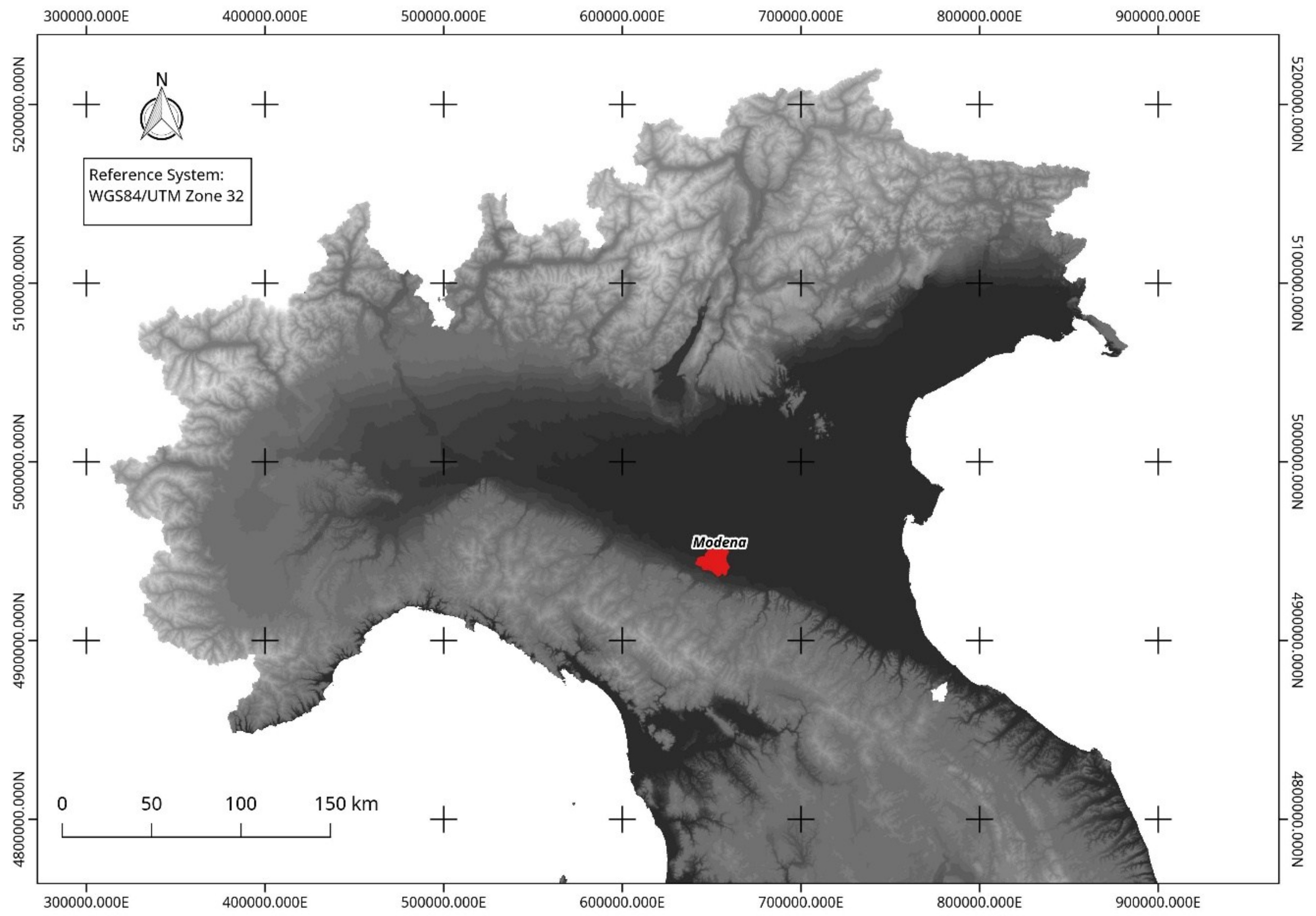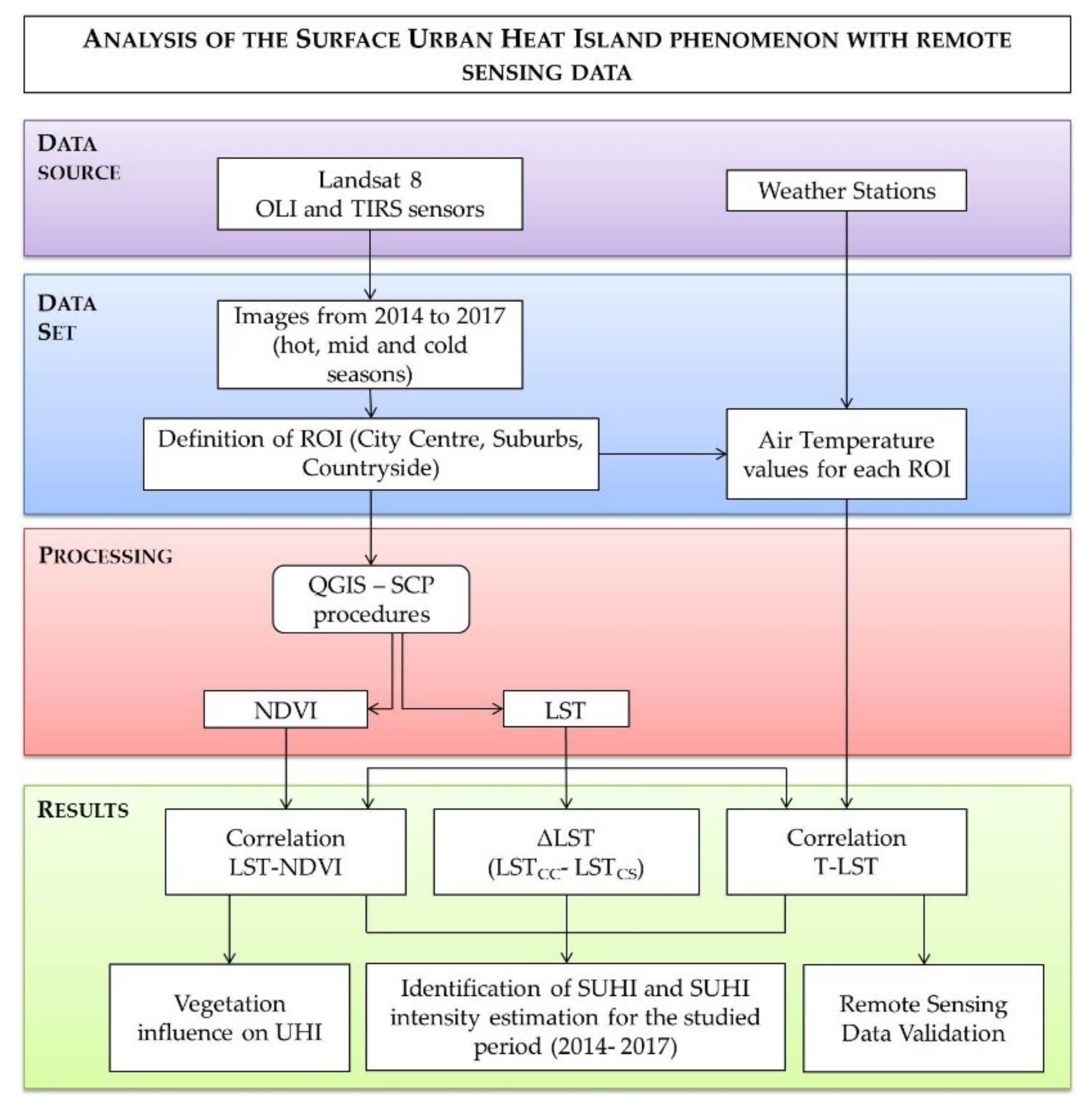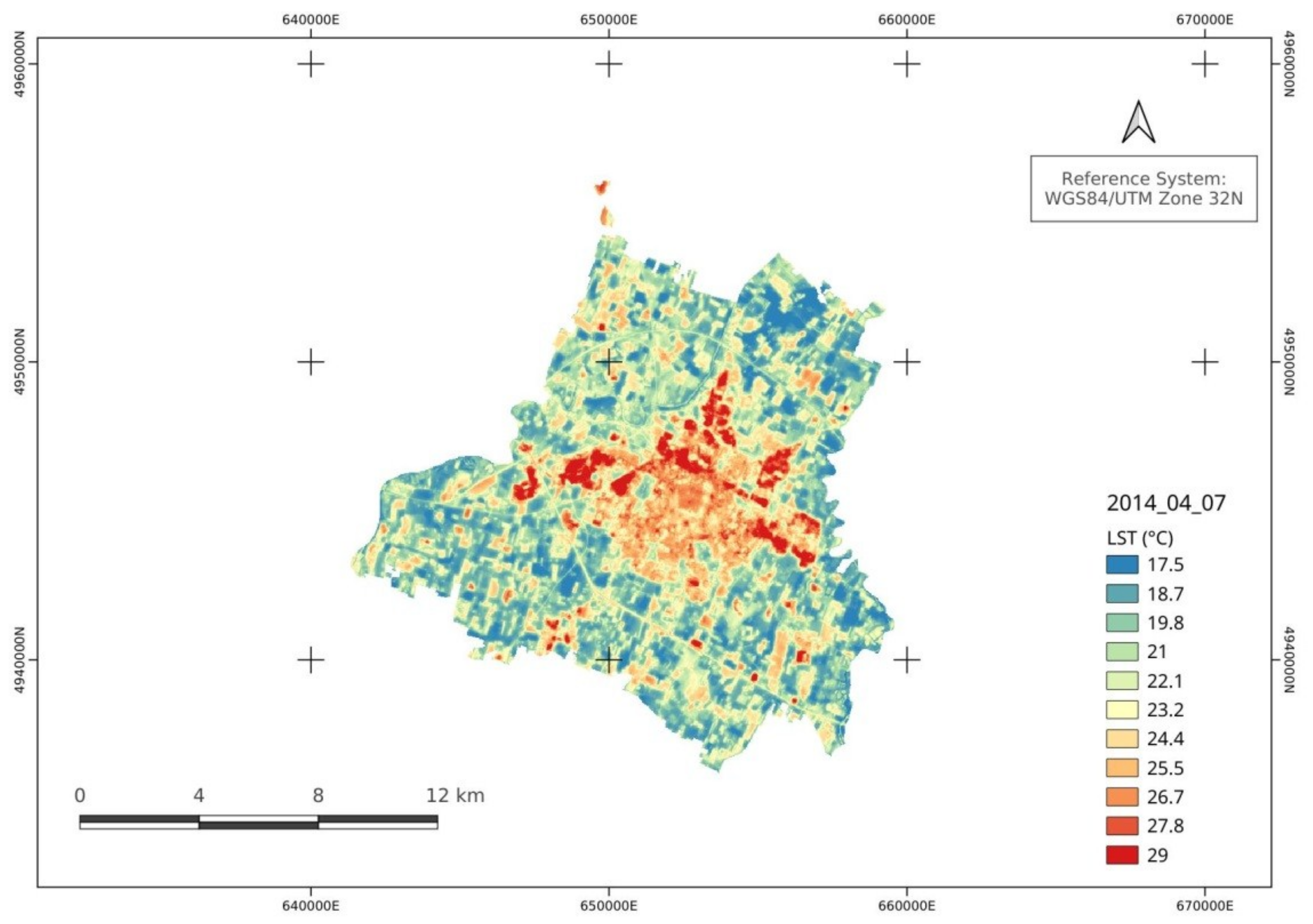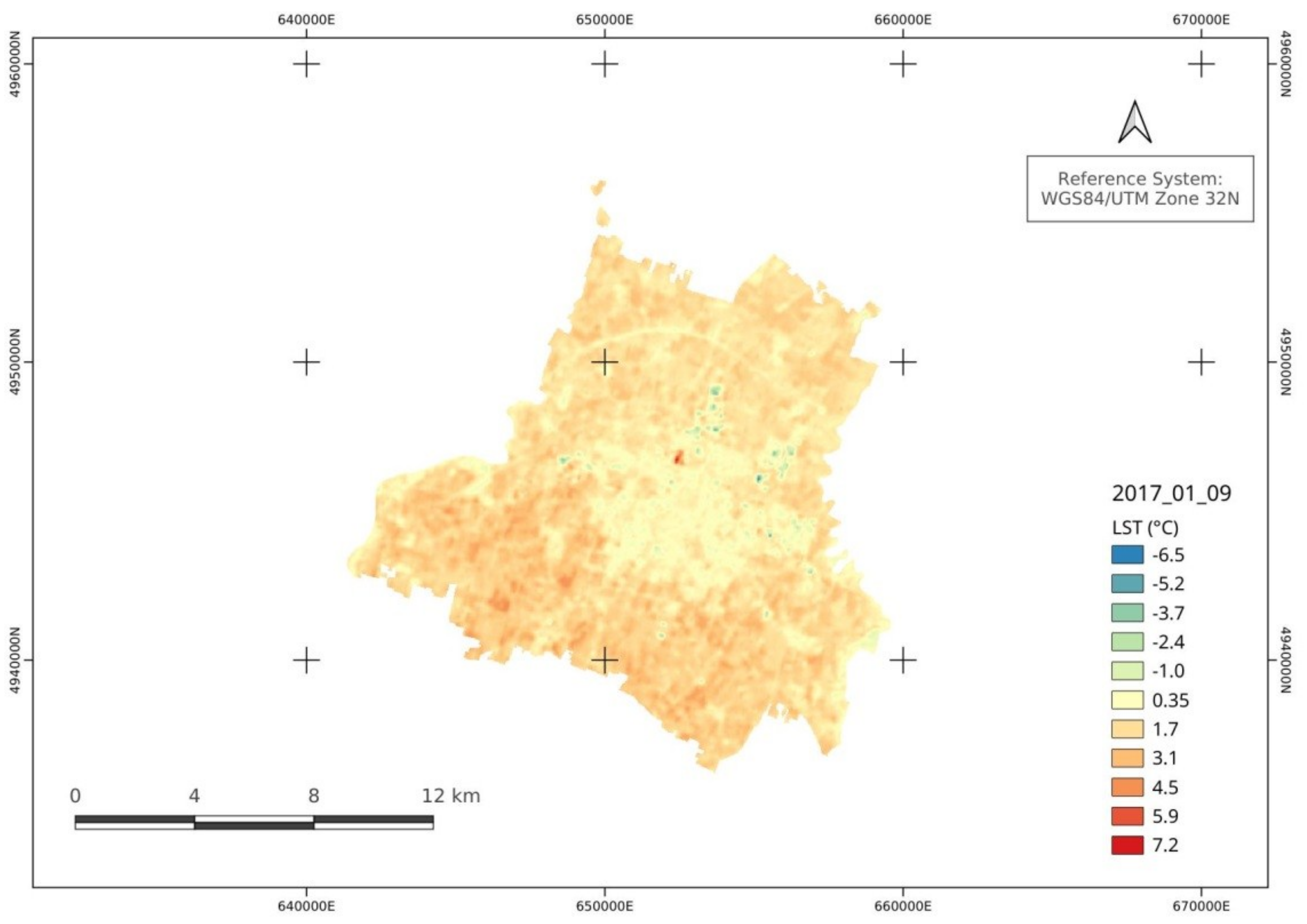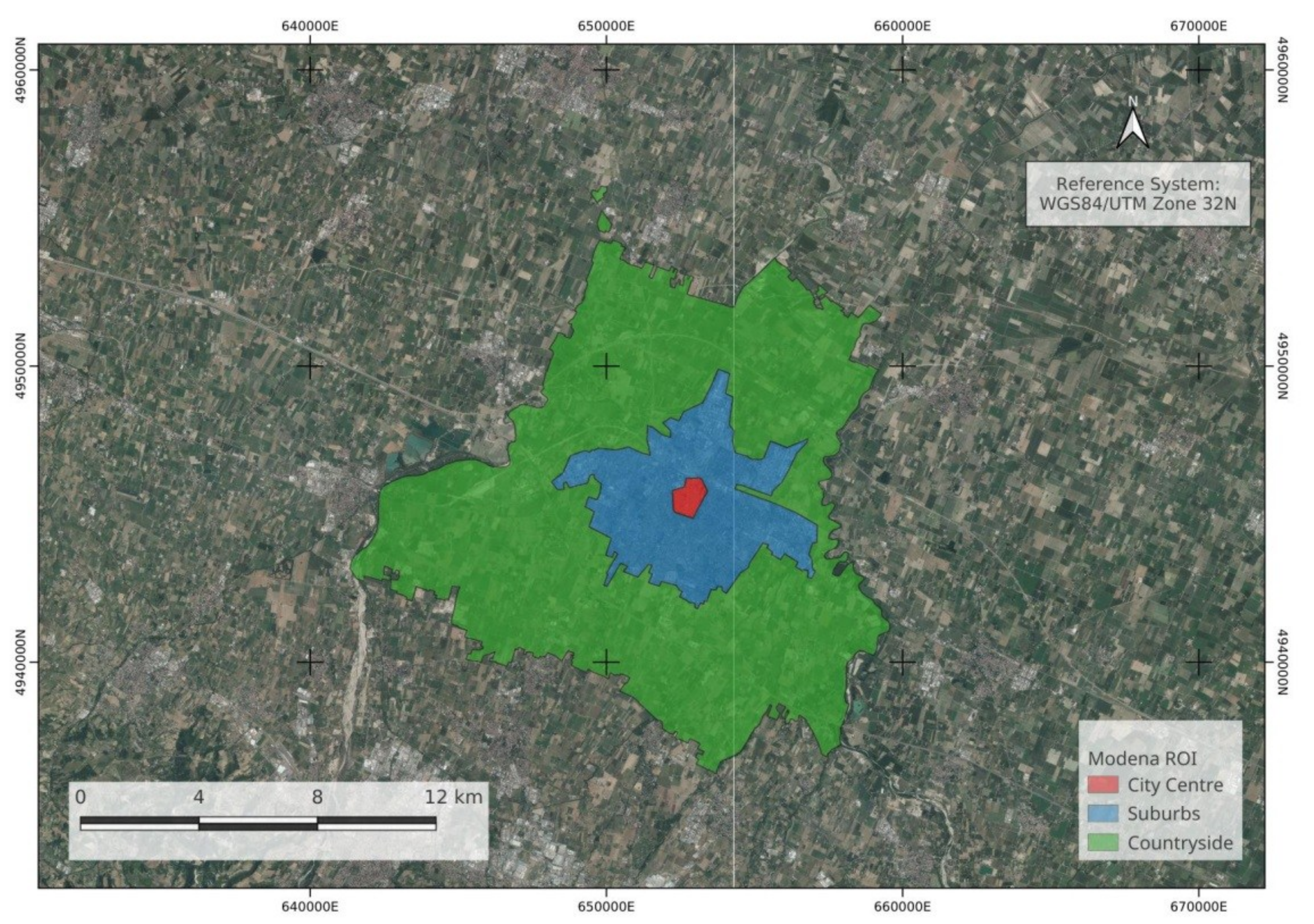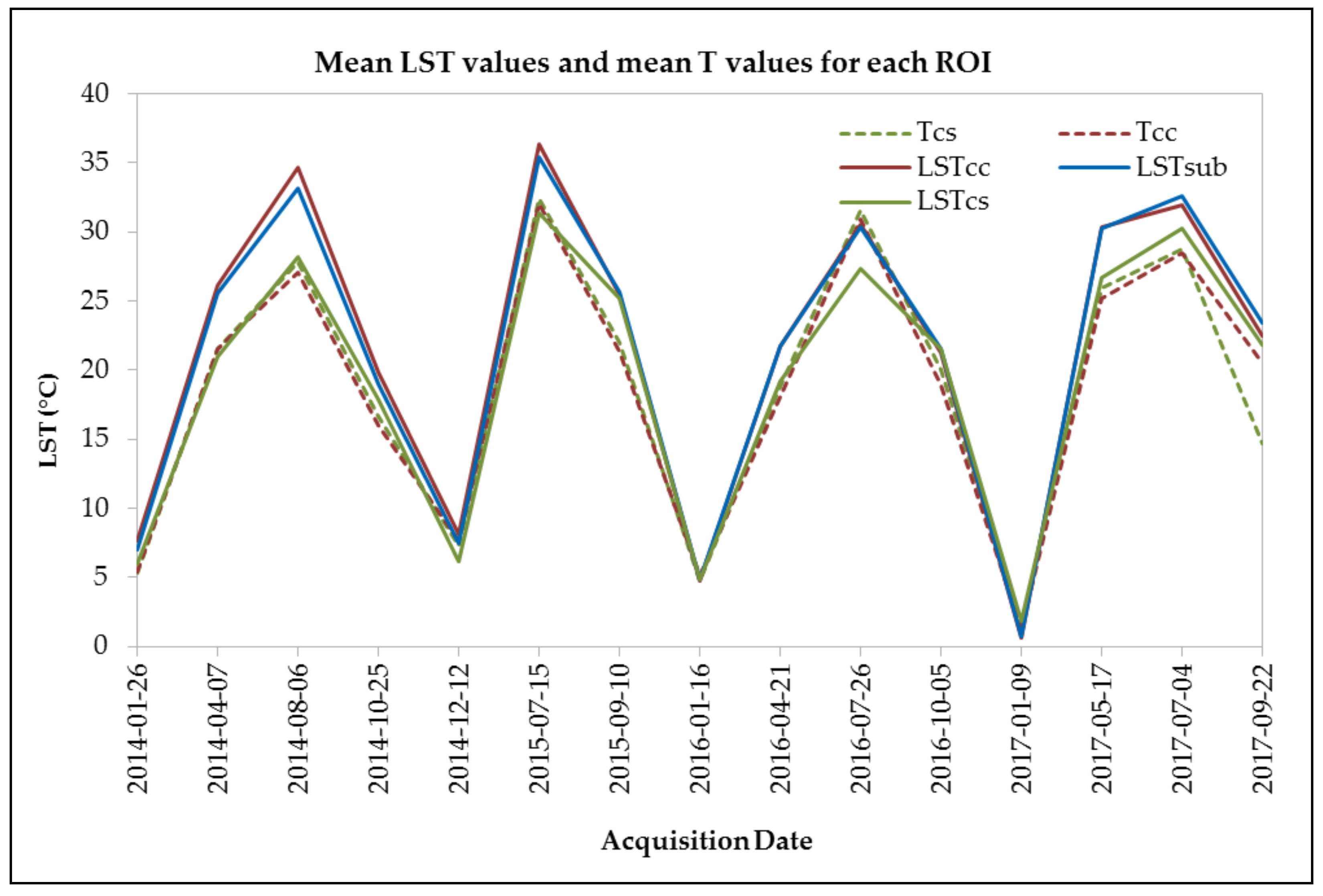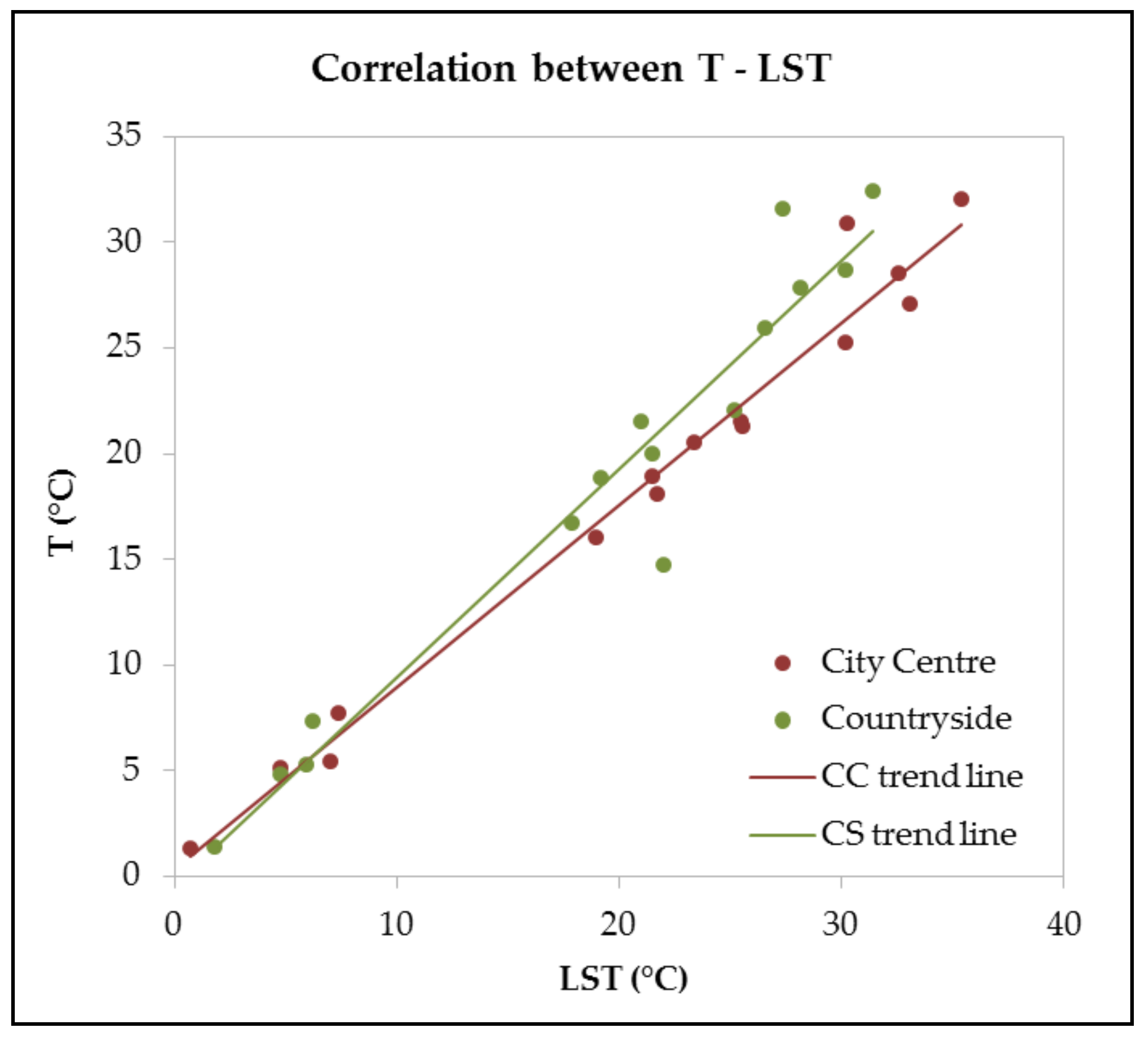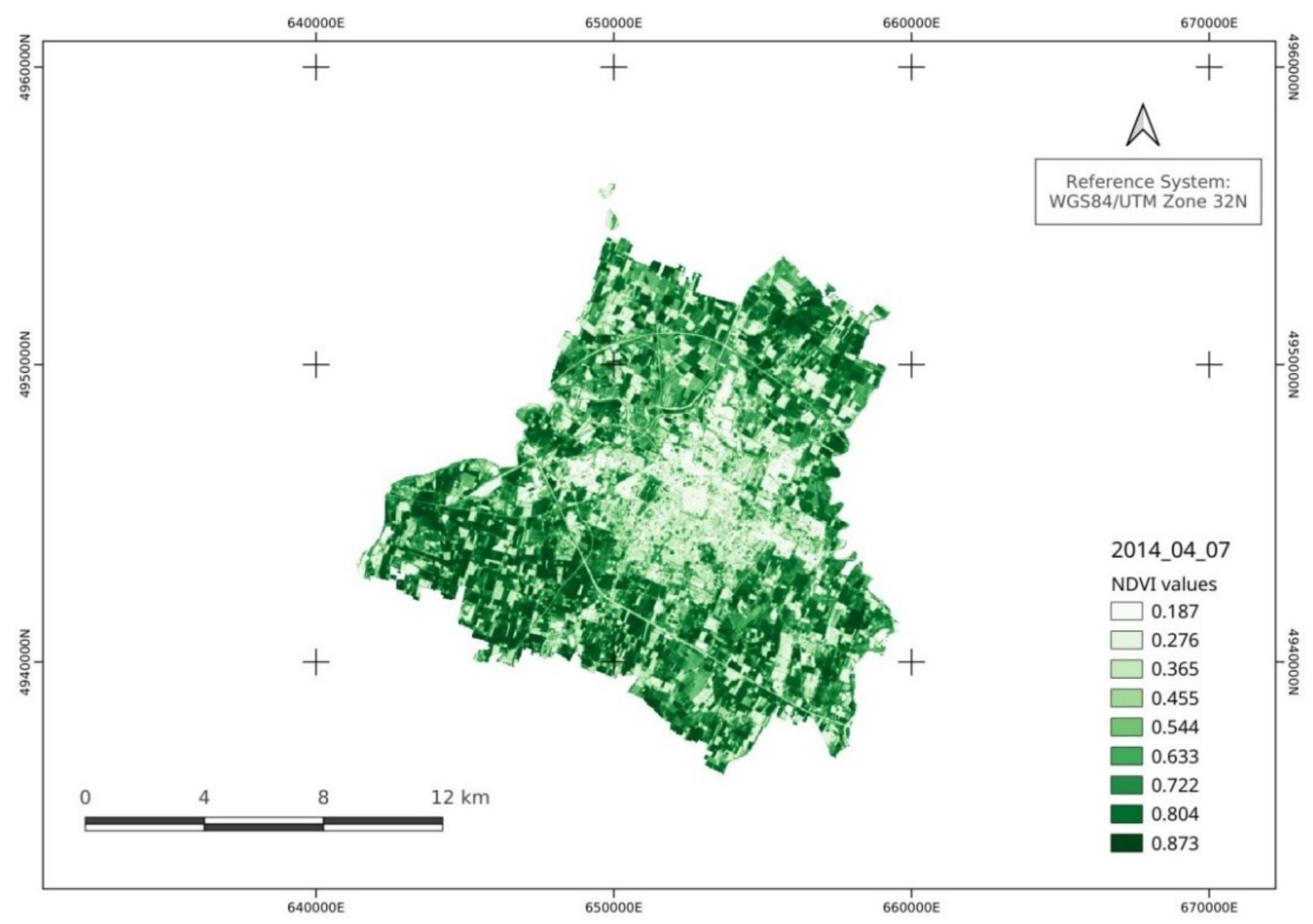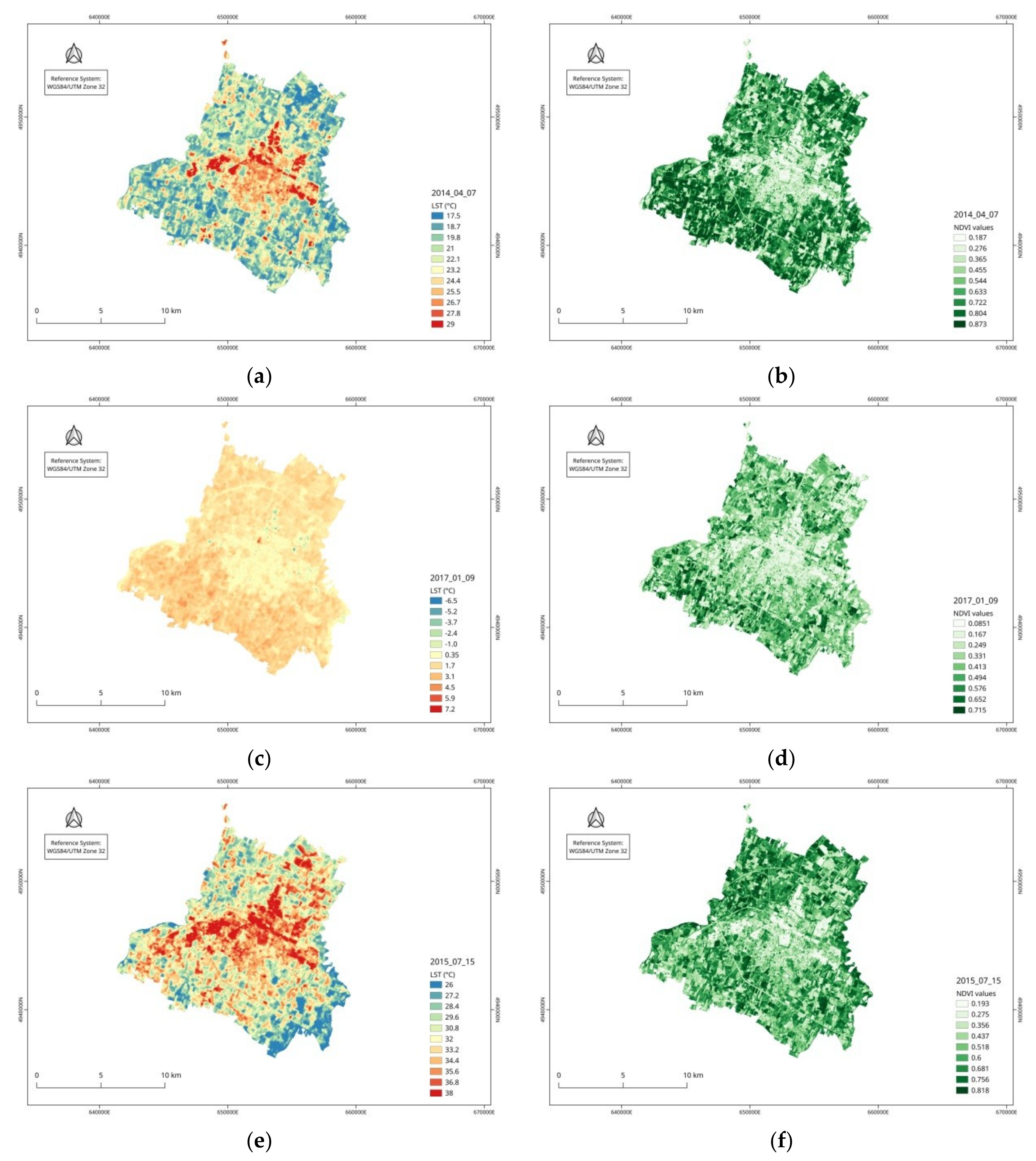1. Background
About half of the world population lives in urban areas [
1]. The global urbanization rate is expected to increase by 70% compared to the current world population [
2], both because of the continued emergence of new urban areas [
3] and because of the constant population migration from rural to urban and suburban areas [
4,
5]. It is not therefore surprising that the negative impacts of urbanization are an ever-growing global concern [
6,
7,
8,
9,
10]. Urbanization has a negative impact on the environment, mainly due to pollution, changes in the physical and chemical properties of the atmosphere, and in the type of cover of the soil surface [
11]. These phenomena lead to so-called Urban Heat Islands (UHI), namely urban areas where the atmospheric temperature is significantly higher than that in the surrounding rural areas [
12]. The presence of UHIs is an increasing phenomenon studied by the international scientific community because of its dangerous and significant effects. In fact, the temperature increase has effects on the environment (higher temperatures cause higher energy consumption, photochemical smog, and worsening of the air quality), on the climate and on human health [
13,
14,
15,
16].
Concerning urban planning policies, nowadays, public administrations have to take into account not only socioeconomic perspectives but also environmental sustainability [
17]. Obviously, the UHI phenomenon is also a topic that has to be considered in administration decisions because it negatively influences population life quality. It leads to thermal discomfort and thermal shock, especially during the hot seasons [
18,
19]. The presence of UHI is typical of highly urbanized areas, but there is currently a progressive increase of this phenomenon not only for metropolises but also for medium-sized municipalities.
The main objective of this study is to investigate the presence, extent, and intensity of Surface Urban Heat Islands (SUHIs) in the municipality of Modena through the use of remote sensing images. Environmental remote sensing is a very useful tool to analyze this phenomenon by calculating the Land Surface Temperature (LST); this is why this study deals with SUHI instead of UHI [
20,
21,
22,
23,
24,
25]. The trend of the LST and the SUHI intensity are highly correlated—an increase of 0.1 °C of the urban LST compared to the rural LST corresponds to an increase of 0.04 °C of SUHI intensity [
26]. This result, however, is retrieved only in the Mediterranean area, due to the specific characteristics of the cities of this region, which may not be found in other parts of the world.
Also, SUHI and UHI phenomena are strictly correlated and in particular the SUHI represents an indirect estimate of the UHI [
27,
28]. In scientific literature, a variety of studies have combined LST, usually used for the SUHI phenomenon, and air temperature data, usually used for the UHI phenomenon [
29,
30,
31,
32,
33].
Some preliminary assessments on the study area are mandatory to understand and analyze results. First of all, Modena has different characteristics from the American cities that are usually used to define the UHI phenomenon [
34]. Modena is a medium-sized municipality, without a high urban density and with a surrounding countryside with a lot of little villages. Instead, American metropolises usually have a very high urban density and the surrounding areas are empty. For these reasons, the difference of temperatures between cities and the countryside are not as high as in other studies in scientific literature dealing with bigger cities.
Furthermore, Modena has many well-distributed green areas that contribute to reduce the UHI phenomenon and to mitigate the temperatures in the areas that have a high urban density. Indeed, green areas are one of the most common strategies used to mitigate UHIs [
17,
35,
36,
37,
38].
The city of Modena therefore represents a different area from those usually studied for the analysis of the SUHI phenomenon in the existing scientific literature. In the current state of the art, in fact, it is possible to find numerous studies on UHI related to large cities [
39] both in America and in Asia [
40,
41]. In the Mediterranean area there are many studies focused on large cities such as Barcelona [
42], Athens [
43,
44], Salonicco [
45], and Tel Aviv [
46]. In Italy, numerous studies considered the UHI of Rome or Milan [
47,
48,
49,
50], while recently other studies have been implemented on cities like Bologna [
51], Padua [
52], and Venice [
53]. Concerning the southern part of Italy, currently there is only one study that reports an analysis of the LST of the major southern cities (Bari, Naples, Palermo, and Catania) [
54]. In this study, the LST value of the rural area is not present, thus it is not possible to quantify the SUHI.
For the city of Modena, some considerations of the UHI phenomenon have been carried out in the studies of Bonafè and Zauli Sajani [
51,
55]. Contrary to the methodology presented in this paper, these studies use ground station measurements for UHI intensity estimation. Furthermore, in Reference [
51], not the entire area of Modena is considered but only specific districts.
No existing study in the scientific literature uses remote sensing data on a medium-sized city like Modena, placed in a highly polluted area (Po Valley), to identify and estimate SUHIs. In addition, there are only few studies that use Quantum Geographic Information System (QGIS) procedures (open source software) applied to remote sensing data for these purposes [
56].
Another observation concerns the climate that has characterized the study area in the last two years. In this period, various climatic anomalies occurred as a consequence of the global climate change. In particular, winter was very humid with high temperatures and no snow. Also, summer was quite wet, especially in July and between the end of August and the beginning of September. These weather and climate conditions surely have an influence on the results obtained by remote sensing, because evapotranspiration influences the temperatures of urban and rural areas [
57,
58,
59,
60,
61].
In this framework it is important to highlight that the municipality of Modena, in 2010, put in place a plan of action for sustainable energy (SEAP). This plan is included in the “good practices” for the European Green Infrastructure Strategies because it provides an increase in green infrastructures in agricultural areas, ecological zones, and public green. In particular, an increase in urban forest of 127.5 ha has been planned for implementation between 2011 and 2020 [
62,
63].
Thus, using the methodology developed in this paper, the city administrators will have a powerful tool to identify SUHIs and their intensity in different years. In this way, urban policies can be directed to those areas where the SUHI phenomenon is still present and creates discomfort in the population. Furthermore, the public administration could evaluate appropriate mitigation measures such as green roofs, cool materials, and green areas [
64,
65] that lead to a more sustainable life quality. In addition, using this methodology, it is possible to evaluate whether the policies entailed within the framework of the European Green Infrastructure Strategies are producing the desired results.
2. Materials and Methods
The analysis of the SUHI phenomenon in these areas was carried out using an experimental plugin for QGIS [
66], called the Semi-Automatic Classification Plugin (SCP) [
67], that allows use of the free open source software QGIS as a remote sensing software. With this plugin, temperature maps can be obtained from “raw” remote sensing images acquired by the Landsat-8 satellite sensor.
The study area includes the municipality of Modena located in the Emilia Romagna region, Italy. The environmental context is the Po Valley, which is characterized by a high population density and intensive agriculture. The LST was computed using the equation suggested by Weng [
23]. Then, additional processing was conducted in order to create three Regions of Interest (ROI) within each image: the City Center region, the Suburbs region, and the Countryside region. For each ROI, LST maps and Normalized Difference Vegetation Index (NDVI) maps were retrieved. Creating these ROIs also allowed the estimation of the temperature difference between Countryside and City Center, and thus allowed us to correlate it with the SUHI phenomenon in the studied period (2014–2017) [
68,
69,
70]. Finally, NDVI maps were used to analyze the correlation between land cover and LST maps.
2.1. Study Area
The study area is the municipality of Modena, Italy (
Figure 1). Modena has 184,826 inhabitants and an area of 183.19 km
2 [
71]. Modena is located in the north of Italy, along the “via Aemilia”, an ancient Roman road running from Rimini to Piacenza on the river Po (
Figure 2). The Po Valley is characterized by a high population density and by processes of industrialization and intensive agriculture (it is among the most productive agricultural areas within Europe) [
72]. The climate of this region is partially continental: summers are hot with intense heat waves while winters are cold and wet, usually with atmospheric stability conditions and fog. Normally precipitation is concentrated during autumn and spring. Summer and winter are the driest seasons [
57,
58,
72,
73]. In order to have a clear climate situation of the study area,
Table 1 reports some climate information. The data are divided into two series: an historical series from 1971–2000 and another time series from 2001 to 2017. For each series,
Table 1 shows values of seasonal mean temperature, seasonal mean of the maximum daily temperatures, seasonal mean of the minimum daily temperatures, and seasonal mean of precipitation. The data referred to the City Center region were acquired by the Weather Station “Osservatorio Geofisico di Modena”, located in the urban area of Modena (Long: 10°55′47.2″ E, Lat: 44°38′52.9″ N) [
74], while the data referred to the Countryside region were acquired by the ARPAE Weather Station of Albareto (Long: 10°57′24″ E, Lat: 44°42′7″ N). In
Table 1, all temperature values of the historical series increase in the time series in every season. The increase of the values vary between 1.4 °C and 2 °C. Also, the values of precipitation increase in every season except summer. In Modena, starting from the 1980s, climate change has exhibited the same trend as the global climate change. The changes cause extreme events such as jumps in temperature or increases in the distribution and amount of precipitation [
57].
The area of Modena was chosen as a first area of interest for the proposed methodology for its characteristics in terms of:
Dimensions. Modena is a medium-sized municipality and the scientific literature does not investigate SUHIs of these kind of cities with remote sensing data;
Climate situation;
Geographical position. Modena is located in one of the most industrialized areas of Europe, as well as one with the highest levels of air pollutants [
75];
Active urban policies. Analyzing three years of data allowed us to investigate whether urban policies on green infrastructures are effective or not.
These characteristics render Modena an ideal test site for the developed methodology.
2.2. Landsat-8 Data
The Landsat-8 satellite was successfully launched on 11 February 2013 and deployed into orbit with two instruments on board: (1) the Operational Land Imager (OLI), whose spatial resolution is 30 m, with nine bands in the visible (VIS), the near infrared (NIR), and the short-wave infrared (SWIR) spectral regions; and (2) the Thermal Infrared Sensor (TIRS) with two spectral bands in the long-wave infrared (LWIR) region. The spatial resolution of TIRS data is 100 m with a revisit time of 16 days [
75,
76,
77,
78,
79] (
Table 2).
The data used for this study are the “raw” remote sensing images acquired from the Landsat-8 satellite sensors, provided free of charge by the United States Geological Survey (USGS) (
Table 3).
Images were divided into three seasons depending on mean LST values retrieved by satellite data: hot season (LST > 30 °C); mid season (10 °C < LST < 30 °C); cold season (LST < 10 °C).
As reported in
Table 3, there are 15 daily images covering about the hot, mid, and cold seasons of four years. The scene center time is about 10:00 UTC. Only images with a clear-sky condition were selected.
There are only two images from 2015 because of the cloud cover, but winter 2015 can be represented by the image taken on 12 December 2014. Autumn 2015 can be represented by the image taken on 10 September 2015, which presents typical autumnal climatic conditions. Therefore, the year 2015 can be considered completely covered, except for spring.
For the entire procedure, the Semi-Automatic Classification Plugin (SCP) on the open source software QGIS was used. The SCP plugin allows one to use remote sensing functions in QGIS [
22,
24,
67]. The methodology, from input data to obtained results, is shown in the conceptual diagram in
Figure 3. Each step is described in detail in the following subsections.
2.3. Data Processing
a. Conversion to Top of Atmosphere (TOA) Radiance
OLI and TIRS band data can be converted to top of atmosphere (TOA) spectral radiance using radiance rescaling factors provided in the metadata file [
80]:
where:
Lλ = top of atmosphere spectral radiance (TOA) (W/(m2 srad μm)).
ML = band-specific multiplicative rescaling factor from the image metadata (W/(m2 srad μm)).
AL = band-specific additive rescaling factor from the image metadata (W/(m2 srad μm)).
Qcal = digital number (DN).
b. Conversion to TOA Reflectance
OLI band data were converted to TOA planetary reflectance using reflectance rescaling coefficients provided in the image metadata files [
80]. The following equation is used to convert DN values to TOA reflectance for OLI data:
where:
c. Conversion to At-Satellite Brightness Temperature
TIRS band data were converted from spectral radiance to brightness temperature using the thermal constants provided in the image the metadata file [
80]:
where:
T = at-satellite brightness temperature (K).
Lλ = TOA spectral radiance (W/(m2 srad μm)).
K1 = band-specific thermal conversion constant from the metadata (W/(m2 srad μm)).
K2 = band-specific thermal conversion constant from the metadata (K).
d. Clip of the image using the shapefile of Modena municipality, provided for free by the cartographic archive of the Emilia Romagna region (official website “Geoportale dell’Emilia Romagna”)
e. Calculation of Normalized Different Vegetation Index (NDVI)
This index is computed using spectral reflectance in the near infrared band and in the red band. It provides a rapid estimation of the presence of vegetation. NDVI values ranges from −1 to 1. Higher NDVI values indicate dense vegetation while lower values (typically from 0 to 0.2) identify light or dark soils [
24]. NDVI is computed using the following equation:
where:
f. Fractional Vegetation Cover (FVC)
NDVI was used to calculate FVC, an index that estimates the proportion of an area covered by a set of predefined type of vegetation or soil cover [
24].
The following equation is used to calculate FVC:
where:
The NDVI
s value was set equal to 0.1, while the NDVI
v value was set equal to 0.65 [
22].
g. Calculation of Land Surface Emissivity (LSE), which is a measurement of the capacity of a material to radiate energy [
24]
where:
h. Estimation of LST
LST can be calculated from the at-satellite brightness temperature T
B [
23]. LST was first computed in K, then converted to °C.
where:
λ = wavelength of the emitted radiance (11.5 μm for band 10 in Landsat-8 OLI).
c2 = h × c/s = 1.4388 × 10−2 m K.
s = Boltzmann constant = 1.38 × 10−23 J/K.
h = Planck’s constant = 6.626 × 10−34 Js.
c = velocity of light = 2.998 × 108 m/s.
ε = emissivity.
4. Conclusions
In this work the presence, extension, and intensity of the SUHI in the municipality of Modena were studied using Landsat-8 data.
The results showed that with satellite data, the SUHI is clearly visible during hot and mid seasons, while an opposite phenomenon is observed during cold seasons.
In particular, during hot seasons, Modena records a significant SUHI phenomenon, with a difference between City Center LST values and Countryside LST values of up to 6.4 °C.
Observing the entire studied period (from 2014 to 2017), the following assessments can be made:
Mean LST values are on average higher from 2014 to 2015 than from 2016 to 2017;
The SUHI phenomenon is more evident during hot seasons, especially in the years 2014 and 2015.
These assessments are certainly consistent with the policies implemented by the municipality of Modena in recent years concerning European Green Infrastructures Strategies. Thus, the application of the methodology presented in this paper highlights the mitigation effect on the SUHI (and therefore on the UHI) of the Modena SEAP agreement.
NDVI maps were useful to identify the vegetation cover and to correlate it with LST maps. This study confirmed that, for hot and mid seasons, high values of LST correspond to low values of NDVI (bare soil or artificial covers). For example, for the image of 15 July 2015, the Pearson coefficient (r) shows a correlation between LST values and NDVI values equal to 0.91 for City Center, 0.79 for Suburbs, and 0.77 for Countryside. For the mid season, the correlation between NDVI and LST is still strong. For example, for the image from 7 April 2014, the Pearson coefficient values are between 0.85 and 0.92. Otherwise, during cold seasons, this study revealed a null or opposite trend of the phenomenon and a low correlation between NDVI values and LST values.
Remote sensing LST values were also compared with air temperature values measured by two weather stations (one for the City Center region and one for the Countryside region). These values showed a high correlation with the Pearson coefficient equal to 0.98 for City Center and to 0.97 for Countryside. Remote sensing data are therefore representative of real surface temperatures and thus they can be used for the identification of the SUHI and the estimation of its intensity.
In conclusion, this study showed that the SUHI is a phenomenon that can also be observed in medium-sized municipalities like Modena and that can be investigated with a free and accessible methodology. The proposed methodology could be easily used not only for the identification of SUHI but also for its intensity estimation thanks to the good correlation between LST values and air temperature values. This study could thus represent a powerful tool for public administration for sustainable planning policies based on UHI mitigation strategies. Using the proposed methodology for several images acquired in different years allows one to monitor the UHI mitigation actions and verify their effect on the territory.
Furthermore, the proposed methodology could be used not only for cities similar to Modena but also for different kind of cities, from large metropolises to small municipalities. For the transferability of the methodology, the choice of ROIs is important: each ROI has to be compared with LCZs definitions in order to set universal benchmarks to compare obtained results.
This study is not concluded. More images will be analyzed, in particular during hot seasons, and, for each image, the Albedo parameter will be calculated to correlate the SUHI to surface reflectance. Moreover, complete meteorological data will be collected in order to better understand the SUHI phenomenon, taking the local climate into consideration. Additionally, data such as the daily precipitation of the three days before the image acquisition time, the average daily wind speed, and the main wind direction will provide a complete climatic and environmental characterization of the acquisition time for each image.

